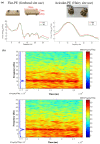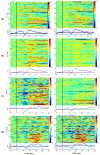New Flexible Silicone-Based EEG Dry Sensor Material Compositions Exhibiting Improvements in Lifespan, Conductivity, and Reliability
- PMID: 27809260
- PMCID: PMC5134485
- DOI: 10.3390/s16111826
New Flexible Silicone-Based EEG Dry Sensor Material Compositions Exhibiting Improvements in Lifespan, Conductivity, and Reliability
Abstract
This study investigates alternative material compositions for flexible silicone-based dry electroencephalography (EEG) electrodes to improve the performance lifespan while maintaining high-fidelity transmission of EEG signals. Electrode materials were fabricated with varying concentrations of silver-coated silica and silver flakes to evaluate their electrical, mechanical, and EEG transmission performance. Scanning electron microscope (SEM) analysis of the initial electrode development identified some weak points in the sensors' construction, including particle pull-out and ablation of the silver coating on the silica filler. The newly-developed sensor materials achieved significant improvement in EEG measurements while maintaining the advantages of previous silicone-based electrodes, including flexibility and non-toxicity. The experimental results indicated that the proposed electrodes maintained suitable performance even after exposure to temperature fluctuations, 85% relative humidity, and enhanced corrosion conditions demonstrating improvements in the environmental stability. Fabricated flat (forehead) and acicular (hairy sites) electrodes composed of the optimum identified formulation exhibited low impedance and reliable EEG measurement; some initial human experiments demonstrate the feasibility of using these silicone-based electrodes for typical lab data collection applications.
Keywords: electroencephalography (EEG); scanning electron microscope (SEM); silicone-based dry sensors.
Conflict of interest statement
The authors declare no conflict of interest.
Figures












References
-
- Langenhove L.V. Smart Textiles for Medicine and Healthcare: Materials, Systems and Applications. Elsevier; Amsterdam, The Netherlands: 2007.
-
- Paul L., Nunez R.S. Electric Fields of the Brain: The Neurophysics of EEG. Oxford University Press; Oxford, UK: 2006.
LinkOut - more resources
Full Text Sources
Other Literature Sources
Miscellaneous

